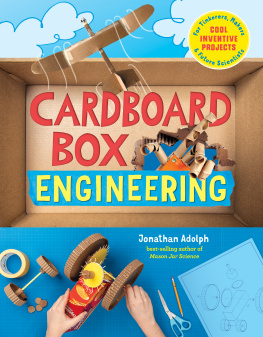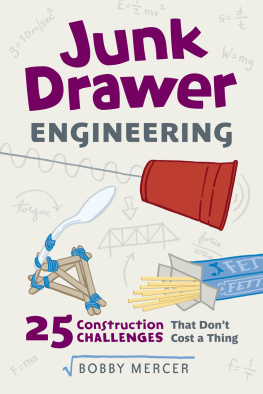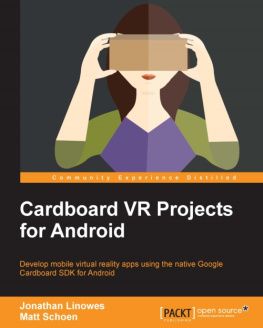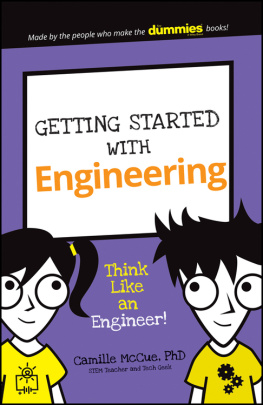For all the engineers of tomorrow who are kids building with cardboard today
The mission of Storey Publishing is to serve our customers by publishing practical information that encourages personal independence in harmony with the environment.
Edited by Deanna F. Cook and Nancy Ringer
Art direction and book design by Jessica Armstrong
Text production and project styling by Liseann Karandisecky
Indexed by Christine R. Lindemer, Boston Road Communications
Cover photography by Mars Vilaubi, Storey Publishing, except for airdone/ stock.adobe.com , front (tape); Jakub Krechowicz/ Shutterstock.com , front (hole in box background); Jessica Armstrong, Storey Publishing, front (airplane); kolazig/stock.adobe.com, front (box)
Interior photography by Mars Vilaubi, Storey Publishing
Additional interior photography by 2020 Artists Rights Society (ARS), New York, c/o Pictoright Amsterdam, b.
Illustrations and diagrams by Ian ONeill, Storey Publishing
Text 2020 by Jonathan Adolph
Ebook production by Kristy L. MacWilliams
Ebook version 1.0
January 4, 2021
All rights reserved. No part of this book may be reproduced without written permission from the publisher, except by a reviewer who may quote brief passages or reproduce illustrations in a review with appropriate credits; nor may any part of this book be reproduced, stored in a retrieval system, or transmitted in any form or by any means electronic, mechanical, photocopying, recording, or other without written permission from the publisher.
The information in this book is true and complete to the best of our knowledge. All recommendations are made without guarantee on the part of the author or Storey Publishing. The author and publisher disclaim any liability in connection with the use of this information.
Storey books are available at special discounts when purchased in bulk for premiums and sales promotions as well as for fund-raising or educational use. Special editions or book excerpts can also be created to specification. For details, please call 800-827-8673, or send an email to .
Storey Publishing
210 MASS MoCA Way
North Adams, MA 01247
storey.com
Library of Congress Cataloging-in-Publication Data
Names: Adolph, Jonathan, author.
Title: Cardboard box engineering : cool, inventive projects for tinkerers, makers & future scientists / Jonathan Adolph.
Description: North Adams, MA : Storey Publishing, [2020] | Includes index. | Audience: Ages 914 | Audience: Grades 46
Identifiers: LCCN 2020030019 (print) | LCCN 2020030020 (ebook) | ISBN 9781635862140 (paperback) | ISBN 9781635863604 (hardcover) | ISBN 9781635862157 (ebook)
Subjects: LCSH: Box craftJuvenile literature. | Cardboard artJuvenile literature. | ScienceExperimentsJuvenile literature.
Classification: LCC TT870.5 .A36 2020 (print) | LCC TT870.5 (ebook) | DDC 745.54dc23
LC record available at https://lccn.loc.gov/2020030019
LC ebook record available at https://lccn.loc.gov/2020030020
Contents
Chapter 2Mechanical Marvels
Robotics & Animatronics
Chapter 3Sights and Sounds
Audio & Optical Engineering
Chapter 4Built to Move
Aeronautics & Nautical Engineering
Chapter 5Elegant Design
Mechanical Engineering
Chapter 6Weve Got the Power
Harnessing Energy
Chapter 7Serious Fun
Game Design

Clockwise: .
Chapter 1
The Science of Engineering
Of all the creatures that have ever lived on this planet, we modern humans are the champions of making stuff. I know, I know: beavers build dams, honeybees create honeycombs, birds make nests, and spiders spin webs. Those are all very impressive, especially when you dont have thumbs! But none of that really compares to what people produce today, and if you doubt me, just ask your mobile phone as you are flying in a jet over a skyscraper. Weve invented a few things that have caused us problems (Im looking at you, atomic bomb!), but far more often, we come up with marvels of engineering that change our lives for the better.
Why is that? What allows people to be so good at building things?
In a word: science. We humans have science, the greatest tool ever invented for figuring out how things work, and how they could be made to work better. Thanks to the scientific method the process of making predictions and then testing them we can try out our ideas and separate the good from the bad. Science is what gives engineers and designers the knowledge to produce all the amazing devices that surround us including every toy, game, and electronic gizmo you own.
And heres the best part: You can be one of those people. You can be a designer and an engineer. With the help of this book, youll learn how to turn old boxes, cartons, tubes, and other cardboard into games, airplanes, robots, roller coasters, and more. And, in the process, youll see what engineering and design are all about.
Why Cardboard?
To learn how to do anything right, you need to practice. And to practice engineering, you need stuff that can be engineered. Thats where cardboard comes in.
Cardboard is an amazing invention in its own right. Its easy to cut and assemble, but its also sturdy and durable. Even better, its free. You probably have a pile of it lying around your house right now: mailing boxes stacked in the basement, cereal boxes and cardboard tubes filling the recycling bin. That means you may already have what you need to start making stuff, and maybe even enough to make a project several times.
And thats important, because engineers know that projects rarely work perfectly the first time. In fact, the best engineers love to make things over and over because each time they do, they get a chance to improve the design. They start by building an experimental model, called a prototype, and then improve it using the scientific method they test the model, see if it works as expected, tinker with it if it doesnt, and then test it again. Whenever something doesnt work out, theyve learned something new.
Almost everything you buy travels by cardboard box 95 percent of all products in the United States, to be exact. That requires about 30 million tons of boxes each year.
Many corrugated cardboard boxes used for shipping have a stamp that gives their rating in an edge crush test, a measure of how strong they are. Look for it on the bottom of the box (A).
As the great engineer and inventor Thomas Edison said,When I have eliminated the ways that will not work, I will find the way that will work.
The cardboard projects in this book let you do just this kind of tinkering. Theyre engineered in a particular way, but other options might be just as interesting. For each project, think about what you are trying to build, how it is supposed to work, and how you might be able to make it work even better. If you hit a snag, be like Thomas Edison and try something else. You might need to substitute a new material for one you dont have or come up with another way to attach two parts. Make adjustments, change the design, test out new ideas, be creative.











